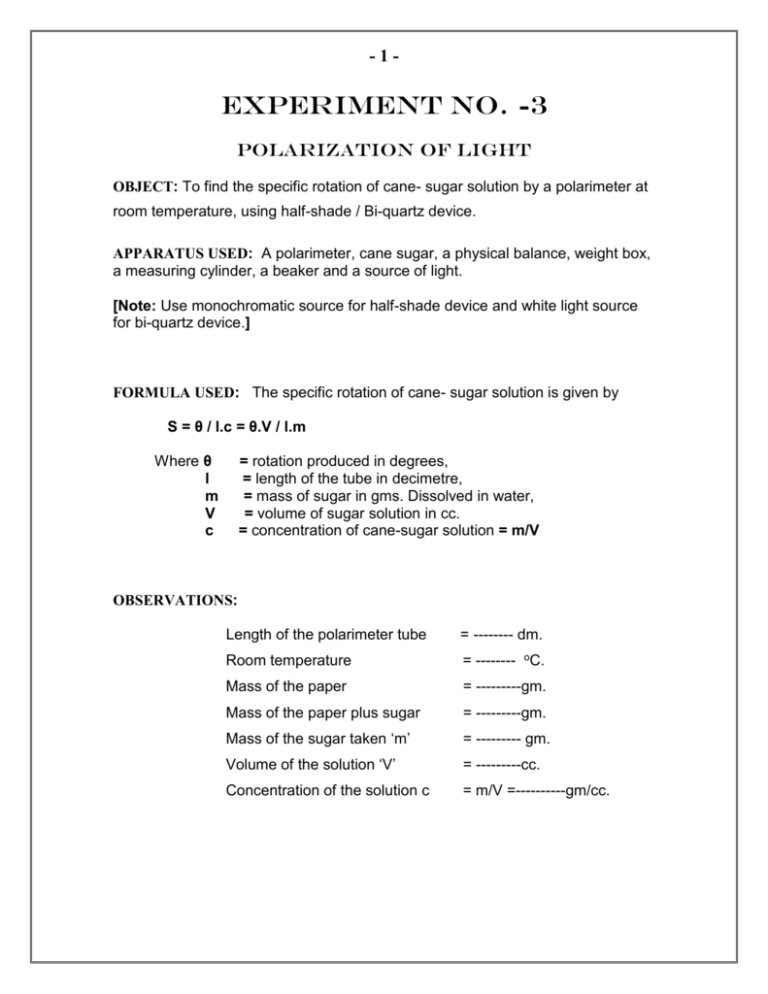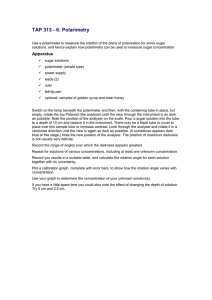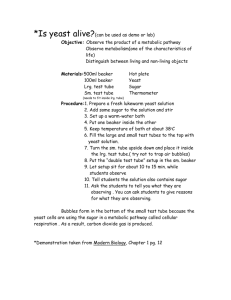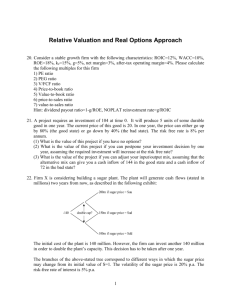Specific Rotation by Polarimeter
advertisement

-1- EXPERIMENT NO. -3 Polarization of Light OBJECT: To find the specific rotation of cane- sugar solution by a polarimeter at room temperature, using half-shade / Bi-quartz device. APPARATUS USED: A polarimeter, cane sugar, a physical balance, weight box, a measuring cylinder, a beaker and a source of light. [Note: Use monochromatic source for half-shade device and white light source for bi-quartz device.] FORMULA USED: The specific rotation of cane- sugar solution is given by S = θ / l.c = θ.V / l.m Where θ l m V c = rotation produced in degrees, = length of the tube in decimetre, = mass of sugar in gms. Dissolved in water, = volume of sugar solution in cc. = concentration of cane-sugar solution = m/V OBSERVATIONS: Length of the polarimeter tube = -------- dm. Room temperature = -------- oC. Mass of the paper = ---------gm. Mass of the paper plus sugar = ---------gm. Mass of the sugar taken ‘m’ = --------- gm. Volume of the solution ‘V’ = ---------cc. Concentration of the solution c = m/V =----------gm/cc. -2- OBSERVATION FOR THE ANGLE OF ROTATION:Value of one division of the main scale (MS) = x Total no. of division on the vernier scale (VS) = y Least count of instrument (LC) = x/y Analyzer reading with pure water Ist position (a) =MS+VSxLC 180o apart position Analyzer reading with solution S. No. Angle of rotation (θ) Conc. in gm /cc. Ist position 180o apart position c=m/V (b) =MS+VSxLC (c) =MS+VSxLC (d) =MS+VSxLC Ist position Mean 180o apart θ =(e + f)/2 e=a~c 1 c1 2 c2 3 c3 f=b~d θ1 θ2 θ3 -3Ray diagram: (Should be on left page by pencil) CALCULATIONS: (Should be on left page by pen) S1 = θ1/ l.c1 =…………; S= S2 = θ2/ l. c2 =………….. ; S3 = θ3/ l. c3 =………… ; (S1 + S2 + S3) / 3 RESULTS: The specific rotation for cane- sugar solution at ________0C is _________ degree per dcm per unit concentration. -4- CALCULATION FOR MAXIMUM PROBABLE ERROR: (Should be on left page by pen) S = θ/ l.c = θ.V/ l.m Taking log both side and differentiate ΔS/S = Δ θ / θ + ΔV / V+ Δ l / l + Δ m/ m = …………. % [Note: Δ θ = 0.1º, Δ V =0.1c.c, Δ l = 0.1cm, Δ m = 0.001gm] SOURCES OF ERROR AND PRECAUTIONS: (i) End faces of the polarimeter tube should be cleaned and fitted air tight. (ii) Water and the solution must be dust free. (iii) There should be no air bubble in the part of light through the polarimeter tube. (iv) The tube should be well rinsed before filling it with the solution every time. PROCEDURE: 1. The least count of vernier attached to the instrument is determined. 2. The eye piece attached to the analyzer is focused on the half-shade. 3. The polarimeter tube is then carefully cleaned and filled with water (taking care that no air bubble is enclosed in it). The tube is now placed at its proper place inside the polarimeter. 4. The source of light is switched on. Looking through the telescope, the analyzer is rotated till the two half of the field of view are equally illuminated (in half-shade arrangement)). This position of the analyzer is noted by reading the main and vernier scales. 5. A second position of equal illumination of the two half of the field of view (in half-shade), nearly 1800 apart of the first position is also noted. -56. A solution of cane sugar of known strength is prepared (say by dissolving 5 gm of sugars in water till solution is 50 c.c.). The solution is kept in a beaker. 7. The water of the polarimeter tube is then replaced by the sugar solution and the analyzer is reset for equal brightness. Both the positions (1st and 180º apart) are found out by taking the readings of the main and vernier scales. 8. The mean of the differences of the corresponding positions of the analyzer (for water and solution) gives the angle of rotation produced by the solution. 9. The experiment is repeated with sugar solution of different strengths. (For this 25cc. of the prepared original solution is taken in the measuring cylinder and water is added to it so that the volume of the solution becomes 50cc. This 50cc. obviously, contains 2.5gm of sugar. The experiment is repeated with this solution. Again 25cc of the above solution is taken in the measuring cylinder and water is added to it so that the volume of the solution becomes 50cc. This 50cc. obviously, contains 1.25gm of sugar. The experiment is repeated with this solution). 10. The length of the polarimeter tube is measured in decimetres. Specific rotation is calculated for each strength of the solution separately and its mean value is evaluated. 11. Plot the graph between concentration and the angle of rotation. It will be a straight line.





